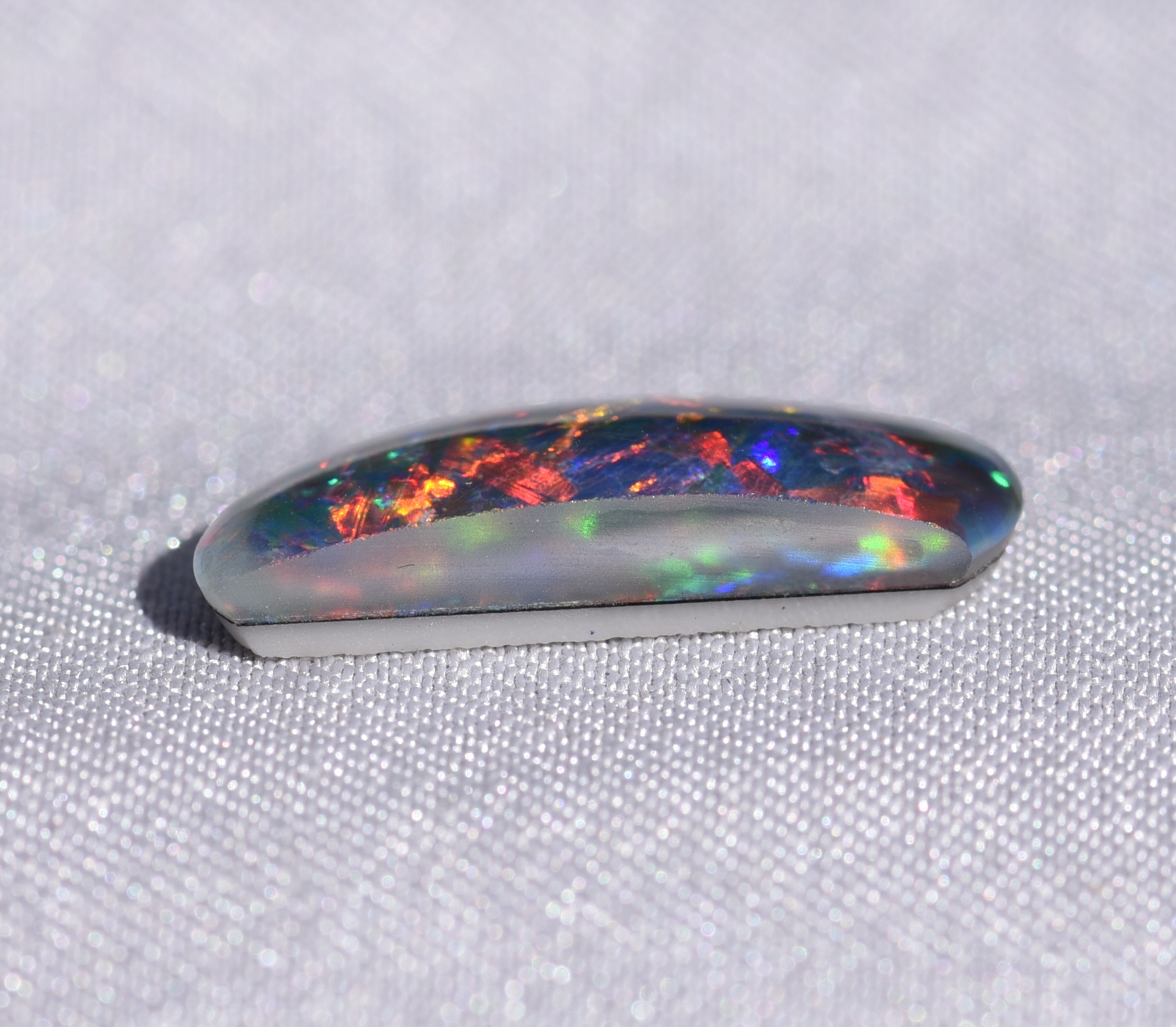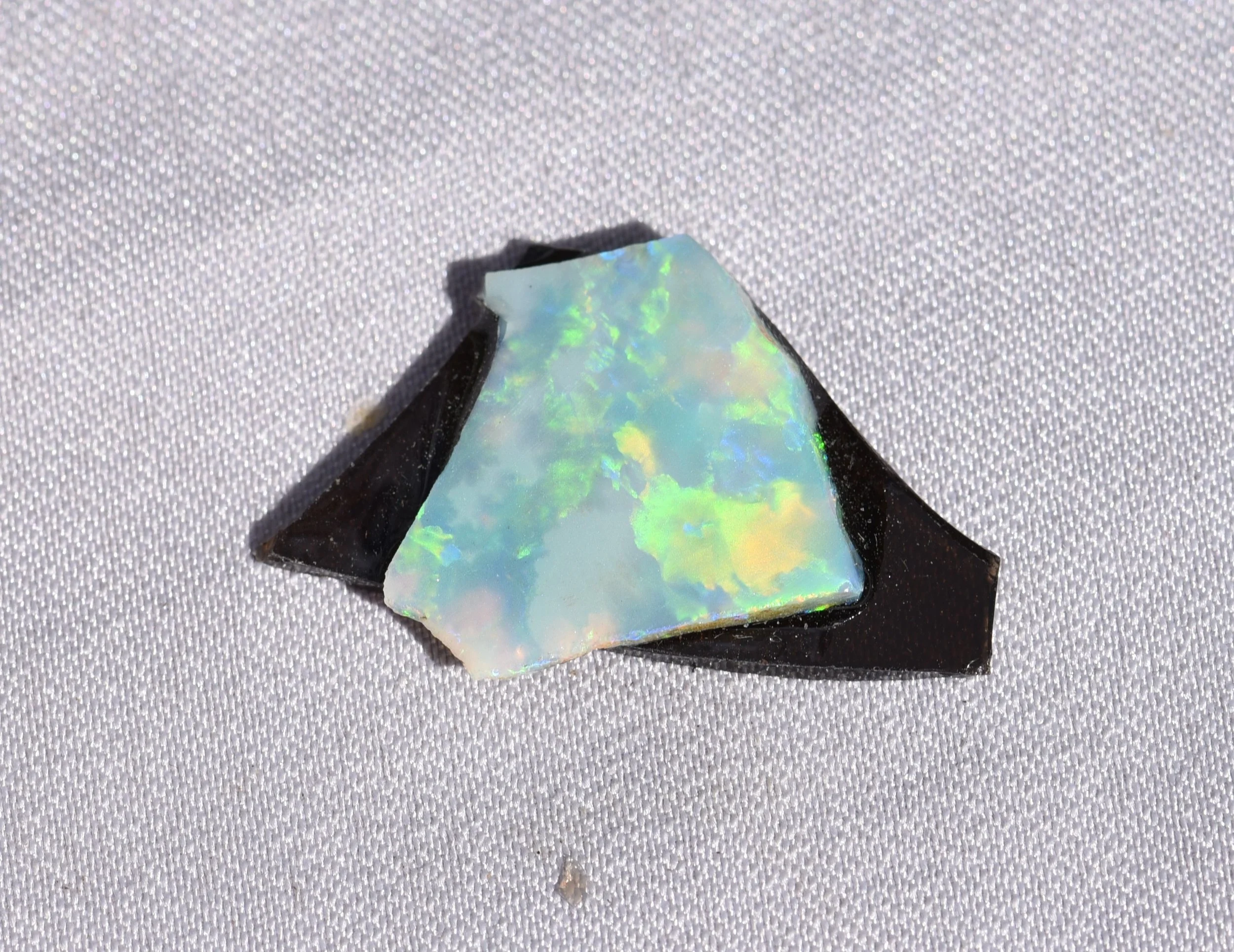Magnetically attracted boulder ironstone matrix opal
A specimen recently appeared across the research table of the opal academy for some testing and analysis. The field of origin is unknown at this time, the specimen was first brought to our attention by a colleague, Alfie Gryg in Western Australia whose client brought the specimen into his business. The client did not have much information. It is thought the origin is from one of the boulder opal fields in Queensland. This is the first example of boulder opal that is attracted to a magnet that we have seen. We invite anyone with information about this or similar opal to have a chat with us at the opal academy.
A free from cut flat cabachon of the magnetically attracted ironstone boulder matrix opal seen recently
A micrograph of the stone pictured left at a magnification of approximatley 20x
A larger magnification (approx 45x of the magnetic ironstone matrix opal
The reverse (back side of the stone.
This specimen of boulder matrix opal is different to most of the other boulder ironstone matrix opal seen. It is strongly attracted to a magnet. See video above.
When first examined this opal presented some mineralogical enigmas. Whilst there is no doubt that there are many different forms of boulder ironstone matrix seen throughout the boulder opalfields in Queensland, and a substantial number of differing forms, patterns and concretions in particular from the Yowah opalfields which provide many differing specimens, this is the first magnetically attracted opal we have seen.
The speciment is also very “black” when compared with many specimens. Even the darkest specimens of boulder matrix seen, have some very dark brown tint. In some Yowah nuts, there are bands of Haematite which when polished gives a typical silvery metallic lustre to the stone. A comparison with this material showed that the heamatite was, as expected not magnetic. Similar comparison was made with a specimen of yellowish brown so called “bubble” ironstone matrix from Koroit in Queensland, and again this material was not magnetic.
As gemmologists are naturally wary about specimens it was considered that the specimen above may have been treated to make it as black as it appeared to be. As mentioned it was expected to have the typical brownish tinge. No treatment could be observed, however further testing will be required to confirm no treatment.
Also examined was the density or specific gravity of this particular specimen as it felt light in heft. The result was surprising with a density (SG) of 2.43.
By comparison the density of a few Koroit matrix opals averaged 2.87, and the small Yowah nut with the polished haematite band was 3.16. It must be acknowledged that the ironstone on boulder matrix an vary significantly from specimen to specimen. These values are given as an indication/comparison only.
After discussion with one of our mineralogists, Bruce Dickson, we considered what options may be available to use which were non destructive, and considered also what available mineral species may offer some insight. A list of iron oxide minerals were discussed, from Ferrihydrite, Maghemite, Haematite, and Magnetite. the two varieties that are magnetic are Maghemite and Magnetite. The suggestion was that the mineralogical test of examining the “streak” of the samples may give a clue..
Photograph of the streak test.
We performed a streak test on the specimen an compared that to known data as well as the aforementioned specimens.
Ferrihydrite has a yellowish brown streak.
Maghemite has a black to dark grey streak
Haematite has a rust or brown red streak and magnetite has a dark grey streak.
From left to right the Koroit bubble opal (yellowish brown), The Yowah ‘haematite’ specimen (reddish brown), a very dark “chocolate” brown specimen, also yellowish brown, and the magnetic specimen on the right, dark grey.
This testing is not conclusive, and it is not suggested that the yellowish brown streak is necessarily indicative of ferrihydrite in this instance, it does however suggest that the dark grey streak may be indicative of the presence of either maghemite or magnetite.
After some more discussion and researching a little further, a correspondent who performed magnetic surveys in the Quilpie district of central Queensland gave us the following information:
“I remember Barry Long doing magnetic surveys at Quilpie to detect ironstone boulders within the Canaway profile some of which contained opal. These ironstones were generally strongly magnetic and produced nice dipole anomalies. Given the highly oxidised environment you wouldn’t expect stoichiometric magnetite to be present. If there is something present (maybe organic material) that arrests complete oxidation to hematite, goethite etc. it is possible that “maghemite” is present in the ironstones. It is not actually pure maghemite, rather something intermediate between magnetite and end member maghemite. Rock magnetists generally refer to this as cation-deficient magnetite. When this was found in the banded iron formations (BIFs) and iron ores of the Hamersley Basin (WA) it was named “kenomagnetite, which seems to be much the same thing. Wherever you get noisy ground magnetics over lateritic soils and regolith and there is evidence of superparamagnetic effects in TEM data, you can bet its this stuff.”
Editors note: Barry Long was one of the Authors in a paper on opal occurrences in Queensland:
Senior, BR., McColl, DH., Long, BE., Whiteley, RJ., (1977) The geology and magnetic characteristics of precious opal deposits, southwest Queensland . BMR Journal of Australian Geology and Geophysics Volume 2. p241-251.
conclusion
The three specimens used in this discussion are shown below. Some mysteries remain about the specimen that is magnetic. We postulate that there is sufficient amounts of magnetite in this particular specimen to make it magnetic even though the density is very low. What the mechanism of formation for this material is also remains a mystery. Comments, ideas and discussion are welcome.
Koroit “bubble’ ironstone matrix opal
Small Yowah nut polished haematite like specimen
Dense dark chocolate brown ironstone matix opal
























